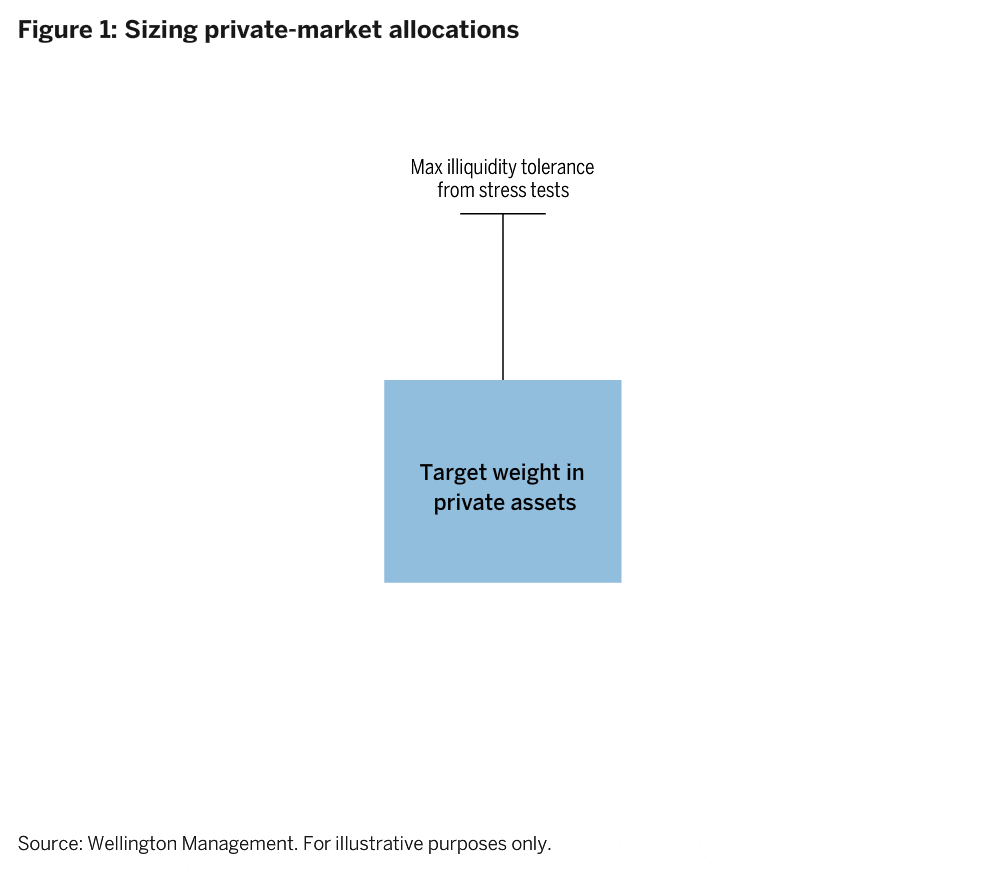- Multi-Asset Portfolio Manager
Skip to main content
- Funds
- Insights
- Capabilities
- About Us
- My Account
The views expressed are those of the authors at the time of writing. Other teams may hold different views and make different investment decisions. The value of your investment may become worth more or less than at the time of original investment. While any third-party data used is considered reliable, its accuracy is not guaranteed. For professional, institutional, or accredited investors only.
Interest in private-market allocations appears to be continuing its steady ascent in 2025. Why? Private assets’ historical returns and diversification potential are attractive to a wide variety of asset owners.
But those considering an allocation to private equity or private credit may be wondering: How much should I own? Sizing private-market exposure is an important part of the investment process, but because of the inherent illiquidity and other characteristics of these assets, we view this decision differently from the process of determining target weights to stocks, bonds, and other asset classes. Specifically, we believe there are three key steps to undertake (Figure 1):

Since illiquidity is a defining characteristic and key return driver for private assets, an asset owner may determine the upper bound of a private asset allocation by asking: How much illiquidity can the I reasonably take on? There are three main types of liquidity constraints to consider when answering:
The vehicles available to help asset owners tap into the private markets are expanding, including some that offer increased liquidity versus traditional private funds. But this said, private investments broadly will generally be less liquid than public-market investments and we think this liquidity consideration is one of the key decision points when allocating to private markets.
Need for excess return (combined with the size of the premium available) can help determine the lower bound of a private asset allocation. This part of the sizing exercise seeks to analyze whether the asset owner can achieve their objectives without taking on the illiquidity and complexity of private assets. If a portfolio needs more return, the asset owner will likely have to increase risk, which is where private assets and their illiquidity risk/reward potential come in. To rationalize an investment in private assets, the asset owner should believe the risk-adjusted return premia not only exists but also is durable and capturable. Estimates of private asset return premia range from as low as 2% to as high as 6% or more, depending on the time period, the sub-asset class (e.g., venture capital, late-stage growth, investment-grade private credit), and the methodology used.
So, prudent private asset owners will need to evaluate how different premia assumptions will shape their allocation weights and the trade-offs between market and illiquidity risk. Weighing these factors together can help identify the minimum private-market allocation necessary to achieve portfolio goals.
Once an asset owner has determined the upper and lower bounds for private assets based on illiquidity tolerance and need for excess return, respectively, the focus can shift to implementation.
It’s important to note that the range of outcomes in private-market investing can vary significantly based on manager and strategy selection. The number of investment options available, access to outperforming managers, and the depth of the managers’ resources all factor into private investment success or failure.
Choosing a “good” manager can be a subjective, challenging business. It’s even more difficult to do so consistently to maintain private-market allocations over time. In our view, strong managers capable of delivering compelling return premia are those who have access to deep resources and ample research, and are disciplined over the long term, regardless of short-term market disruptions or liquidity concerns.
There’s no one-size-fits-all answer to the question of how much you should allocate to private investments. On one hand, private investments tend to be more complicated, regulated, and illiquid than the public-market counterparts. On the other, they have the potential to generate compelling returns and diversify portfolios. Finding the balance between these dynamics will depend on individual investment goals and risk tolerance, and, in our view, doing it well can depend on implementation and manager selection.
To learn more about the art and science of sizing private-market allocations, check out our longer series on the topic, beginning with Sizing private-market allocations: part one.
Experts


Private credit outlook for 2026: 5 key trends
Continue readingVenture capital outlook for 2026: 5 key trends
Continue readingPrivate real estate debt: An evolving opportunity set
Continue readingInvesting in climate solutions across public and private markets
Continue readingHuman capital management for private companies
Continue readingWhat’s the Fed got to do with it? The impact of rate cuts on CLO equity
Continue readingCommercial real estate debt: Transitional assets deep dive
Continue readingURL References
Related Insights
Stay up to date with the latest market insights and our point of view.